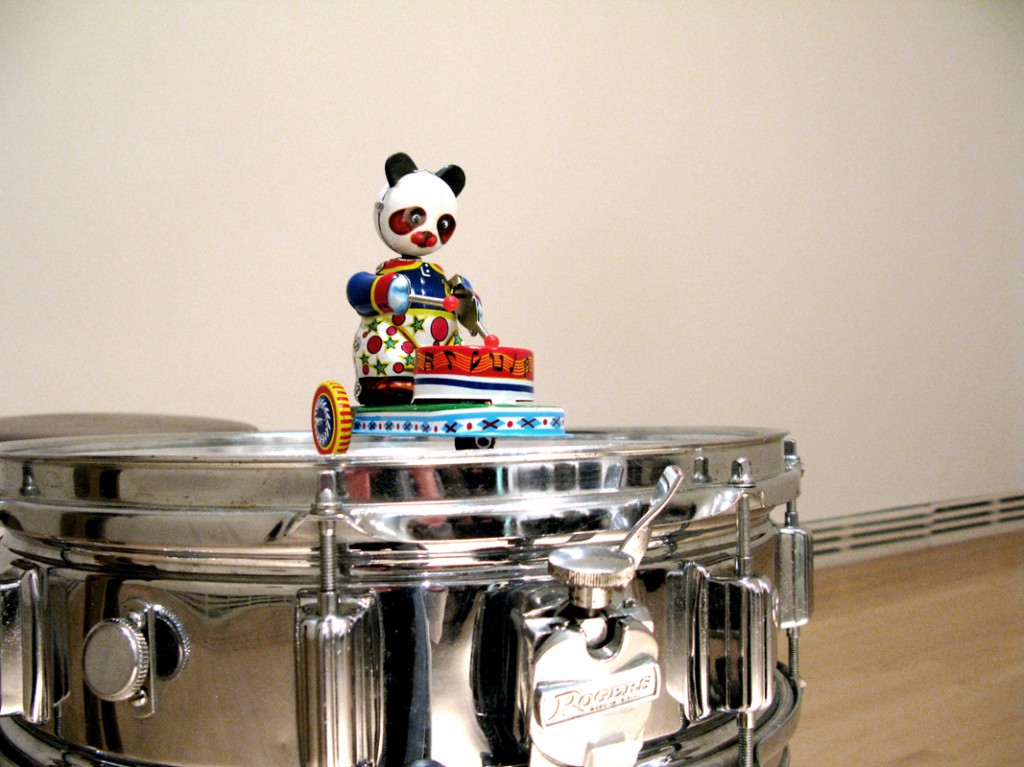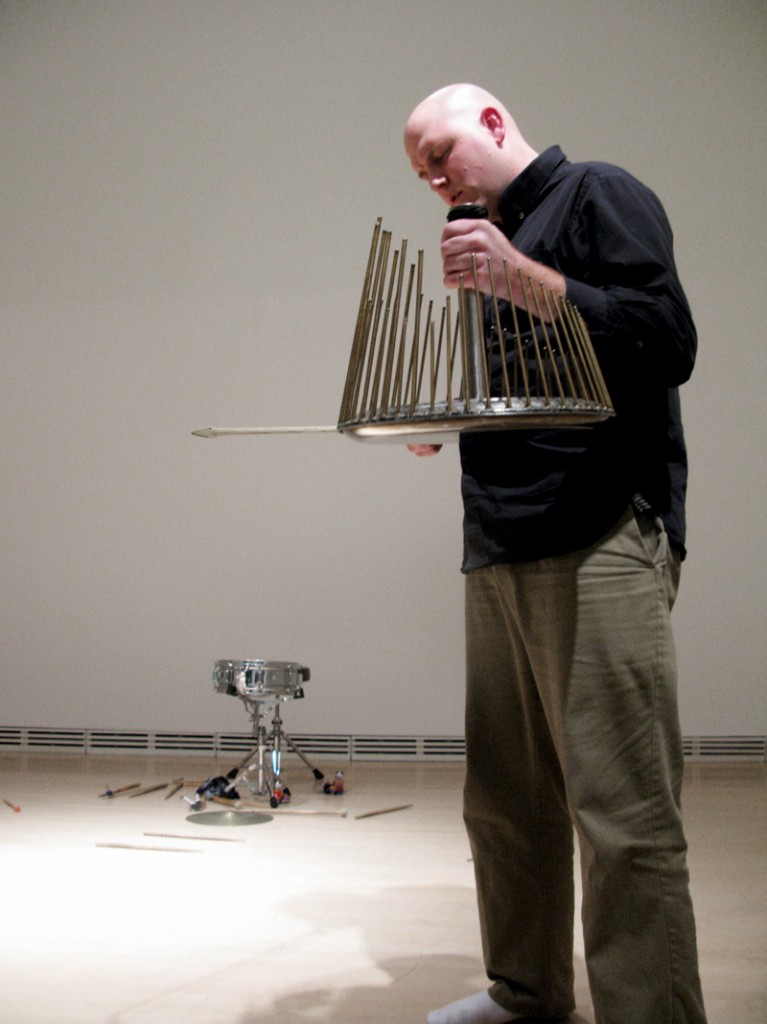It was an intimate setting for Jesse Stewart’s solo percussion performance at CUAG last Saturday afternoon. A hushed crowd gathered in the gallery space where David Rokeby’s interactive sound installation Very Nervous System is currently set up and Stewart, a local percussionist, curator, visual artist, and professor at Carleton University, entranced us with his improvised beats for the better part of an hour.
The performance was incredibly varied and Stewart’s use of unconventional materials and instruments had me fascinated throughout. The set up was fairly minimal: one snare drum in the centre, one cymbal, and then a picnic-like selection of tools and props including various types of drumsticks, brushes and mallets, a handkerchief, a small aluminium bowl, and – best of all – a couple of little panda bear drummer toys, the old tin kind that you wind up in the back and let go.
The panda drummers opened the show, starting off on the drumhead clapping and jerking forward awkwardly, eventually making their way out towards the audience and into the purview of the camera set up for Rokeby’s installation, which caused a surge of low rumbles from the speakers. This interaction with Rokeby’s VNS was unlike anything I’ve seen before. Any trespass on VNS’s territory, whether it was a wave of Stewart’s arm or the wooden clicks of two drumsticks together, resulted in an audible response from the installation.
VNS was on one hand treated as an instrument, forming a part of the chorus of percussive elements composed by Stewart, but it also seemed to have an autonomous character – to function as a musician on its own. This was not so much a solo performance as it was a duet between Jesse Stewart and the computerized personification of David Rokeby.
In the spirit of true experimentation and improvisation, even Stewart could not anticipate the exact reactions that the intuitive installation would have. At one point in the performance, Stewart was playing the waterphone (which we will get to later) and was trying to coax a specific reaction out of VNS, namely, the sound of water trickling. The first two attempts were successful, Stewart mimicked filling his cupped palms with water and VNS reacted to these movements with soft swishing sounds. On the third attempt, he cupped his palm and recreated his movements in the exact same space as he had just moments ago, but silence followed. Again he tried – silence. He paused, tried once more, and an unruly growl emerged from the speakers. Stewart looked quizzically at the audience for a quick instant, which provoked a burst of laughter, and then the performance continued. Such are the difficulties of manipulating an ‘instrument’ which is both invisible and intangible, and exists in a space of unclear boundaries.
Outside of the collaboration with VNS, the performance was buoyant and exciting, showcasing Stewart’s sage-like knowledge of percussion and his innovative techniques using alternative instruments and musical tools. The handkerchief was placed over the drumhead to create dynamic fluctuation, and lent a softness and roundness to the sound, while the aluminium bowl held a small hard object, which was swirled around in order to create a metallic buzzing that resonated down my spine. I found the whole experience surprisingly physical as I could feel each quick snap on the drumhead and all of the tinny accents on the rim pulsing up through the soles of my feet.
Maybe I was getting a little too lost in the performance, but I started thinking about musical rhythms and their biological counterparts (heartbeats, breathing patterns, etc…) and how inherent the enjoyment of percussion is to being human. The wonderful thing about Jesse Stewart’s performance was that it led me to unpack what I was hearing and look at music from a different perspective, but without all of the trappings of a New Age-y bongo drum circle. Stewart’s presentation was professional, nuanced, and refreshingly modern. Freed from the restrictions of conventional music (lyrics, melody, a single sustained tempo), the performance was a welcome detox from the mainstream hyperactive synth-pop sugar high that I embarrassingly indulge in now and then.
The highlight, however, was the not panda toy cameo, nor the Rokeby collaboration, but the mysterious and ethereal-sounding waterphone (pictured above right). The instrument was invented by Richard Waters, and combines a base/chamber that holds water and stainless steel rods that can be played with the fingers, a bow, or mallet. You can read up on it on Waters’ website and a quick You Tube search yields tons of videos of skilled (and a few unskilled) waterphonists in action. Stewart’s mastery of the strange instrument was thrilling to watch. The water in its chamber could be heard sloshing gently around, and the bow vibrating against the steel released dark moans, bottomless echoes, and vibrato hums that were otherworldly. The sounds produced were horror film-worthy; both alluring and unsettling, and seemed almost too robust and multidimensional to be coming from such a modest instrument. So the next time I have $1500 kicking around and several years to master an instrument, I think it’s going to be the waterphone – I’m completely intrigued!
In summation: a super interesting and unique performance by Jesse Stewart and a successful Saturday afternoon!
Nancy Webb
Tags: CUAG, David Rokeby, interactive art, Jesse Stewart, percussion, sound

